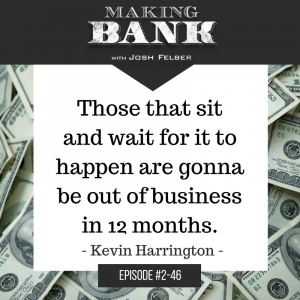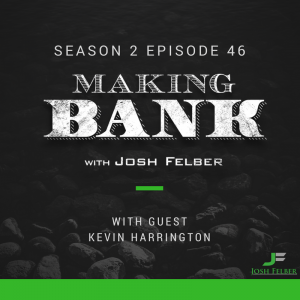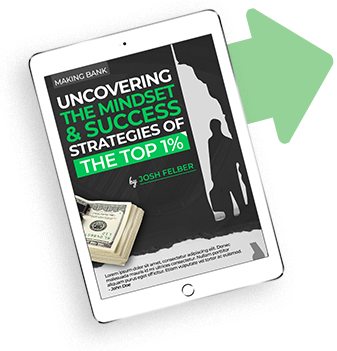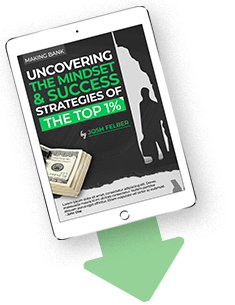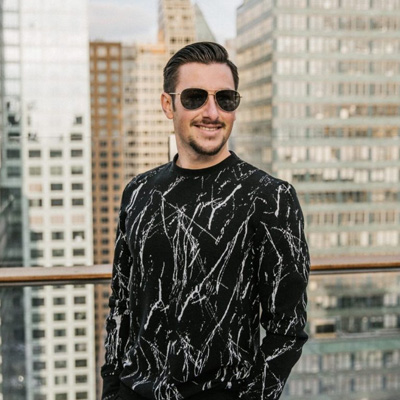Key Investor Insights from an Original Shark with Guest Kevin Harrington: MakingBank S2E46
with Kevin Harrington
Video:
Audio:
bit.ly/JoshFSubscribe
MAKING BANK is now a weekly YouTube TV show and iTunes Podcast full of #Success and #Business with Josh.
Subscribe to iTunes: bit.ly/JoshF_Itunes
Summary
Have you ever watched Shark Tank and dreamed about finding an investor for your own business idea? Maybe you already have a business but you know that an injection of capital is the thing you need to take it to the next level.
Raising capital is not easy to do but there are plenty of things that you can do to improve your pitch and win the attention and interest of investors.
Today on Making Bank, host Josh Felber invites Kevin Harrington to talk about his entrepreneurial journey from inventing the infomercial to investing in businesses like yours as one of the original sharks on Shark Tank. He shares some incredibly valuable tips for raising capital so that you can grow your business to the next level and reach the broader retail market.
Kevin is one of the original “sharks” on the hit TV show Shark Tank, the creator of the infomercial, pioneer of the As Seen on TV brand, and co-founding board member of the Entrepreneur’s Organization. His legendary work behind-the-scenes of business ventures has produced well over $5 billion in global sales, the launch of more than 500 products, and the making dozens of millionaires. Twenty of his companies have each topped $100 million in revenue.
So, tune-in to hear Josh and Kevin talk all-things entrepreneurship and investing on Shark Tank, as well as…
- The art of raising capital.
- Why you need to understand an investor’s sweet spot.
- How to craft the perfect pitch to get the attention of an investor.
- Why having the right people on your team is so important.
And more…
SUBSCRIBE for weekly episodes and bonuses: bit.ly/JoshFSubscribe
Josh Felber: Welcome to Making Bank. I am Josh Felber, where we uncover the success strategies and the secrets of the top one percent so you can amplify your life and your business today. I’m excited for today’s guest, he’s well known whether you’re on TV, Shark Tank, he’s all over TV and the internet. So I wanna welcome Kevin Harrington to Making Bank.
Kevin Harrington: Josh, good to see you, mean. How’s it going?
Josh Felber: Yeah. It’s awesome to be back, to have you on now, for sure, man.
Kevin Harrington: It’s great to be here.
Josh Felber: So for that one percent out there that doesn’t know who you are or what you do, can you give us a quick overview?
Kevin Harrington: Sure, yeah, yeah. So I started 1984, I was watching TV and all of a sudden the screens went dark and found out that the channel was Discovery and it was only an 18 hour a day network. So I said, I’ll fill the other six hours with products. So I started putting products on back in the early 80s. Kitchen products and fitness products, so Tony Little Fitness, and Jack Lalanne and the juicer. And then George Foreman, and all these kind of, you know, we did the Jenners and I did Bruce and Kris Jenner when he was Bruce before Caitlyn, right.
And then we did the Hilton family with Kathy Hilton and then Paris Hilton, you name it, I’ve done this As Seen On TV infomercial kind of business. So hundreds of products of five billion dollars in sales, give or take. So you know, I’m kind of like a creator of this infomercial space. And now what’s happening is there’s a little bit of disruption going on there, and actually, you mentioned Shark Tank, so I got a call from Mark Burnett along the way and I did actually 175 segments on Shark tank.
Josh Felber: Wow, and you were one of the first ones, right?
Kevin Harrington: Yeah, I was in the first go round. And there’s five segments to a show, so 35 one hour shows I shot in the beginning of Shark Tank. And now, they all run reruns on CNBC, plus they run all around the world. It’s running in dozens of countries. So it’s been kind of a good run from being in the infomercial space and Shark Tank. And now, I have a chance to see what’s going on in the market. You know, and TV viewership is dropping, and so I said, there’s disruption. And where are they going? Well, they’re going to social media, they’re going to Facebook.
People spend hours a day on Facebook instead of sitting in front of their TV set. So I’m having to follow the eyeballs. And as you know, this is the future, digital. So that’s what we’re doing.
Josh Felber: For sure, yeah. Awesome. And so I mean, and you got to see the whole spectrum, you know, being on TV as well as now with the whole digital marketing and everything else. As you were growing in TV and everything else, what were some of your biggest challenges that you – or maybe, one or two biggest challenges that you encountered along the way?
Kevin Harrington: So, I mean, look. When we first started putting products up, we’d have big success. And now it’s like, okay, well success equals financial distress. Because you need inventory. So I’m like, okay, I need … I was selling Ginsu knives at one point. I’m selling Chinese woks, and I’m selling Tony Little Fitness products, and I need 200,000 of them, okay? Of each one. So how do I get a million pieces of inventory that costs ten bucks a piece? That’s ten million dollars, right?
Well, I had to get very creative in raising capital and going to banks and going to venture capitalists. You know, cause when I started, I didn’t have any money, right? So now, every one I could get I would make a profit. So we’ve actually started just bootstrapping out of profits. You know, we’d sell a few, take the profits, go back, buy more inventory. But eventually, one of the biggest things, I think the breakthrough for me, was learning how to raise capital and talk to investors.
So nowadays, my business model is a little different. I’m still a product guy, but I’m now more of a business guy. Like, I invest in businesses and get equity and some of these are public companies. So I’ll take capital to put into companies, but I will then help them go raise money. Because at the end of the day, without capital, it’s very tough to build any business, you know?
And you have to, you know, there’s an art to raising capital. And one of the things I talk about is creating the perfect pitch. So there’s a pitch to get on Shark Tank and get somebody to say yes to being your partner. But that’s also kind of involving – getting a partner, raising capital, it’s the pitch to get investors. And that’s a little different than a pitch to sell the product, obviously, right?
So that first challenge was money related, and then the next part of it was getting the right team. Cause in the 80s, there was not a sophisticated world of marketers, digital, I mean, today –
Josh Felber: Nobody knew what digital marketing was back then.
Kevin Harrington: Yeah, so many different, you know, back then it was like, who’s gonna process my credit cards? Well, my local bank was my processor. They had no idea what they were doing even, you know? So today things are a lot more sophisticated. You got somebody that does everything, and this digital world, it’s amazing.
Josh Felber: And you mentioned with the credit card processing, so one of the companies I own, for a while, we were one of the first companies to start deploying electric credit card terminals. And then when I sold that company, it was right around ’97, so I came back to Ohio and started helping a friend of mine who had still his merchant service company. And we were one of the first companies to start setting up online merchant processing back when you had to go in and code the website and put all these secure links back and forth and everything else. So it was like, way early cutting edge, and it was – like the 80s, basically.
Kevin Harrington: And I was doing this in ’84, ’85, ’86. And –
Josh Felber: And it was all over the phone, probably? And –
Kevin Harrington: One day my auditor said, “What are we selling for a thousand dollars?” And I said, “What do you mean?” He said, “Well, this month we issued 20 one thousand dollar credits.” And I’m like, “Well, that’s very strange. We’re selling 29 dollar knife sets.” Well, the girl in my accounting department was issuing thousand dollar credits to her friends and relatives, okay? Because somebody had to tell the bank, okay, put a credit on this account.
Because we had no controls, and we learned the hard way. By the way, that wasn’t the first month she did it, either. So. It took me six months to figure this out. We got crucified, you know. Never got it back, because she’s, you know. But we learned the hard way many, many things. Right? So, and that was really putting – I said, get your dream team. Getting the right kind of controls in finance. Needing to get the right CFO, okay? Because a good CFO can have controls for that. But we just didn’t even know what to do right, you know?
Josh Felber: Think about it back then, yeah.
Kevin Harrington: So now we’re a little smarter, okay? Or we’d be out of business, I’ll say that.
Josh Felber: So companies that are growing their business, they may be not at that CFO level. So how do they protect themselves? So if you were back in that same situation?
Kevin Harrington: So this is, you know, I talk in front of crowds and one of the things I saw is that with this, what I call the gig economy. The you economy today, I say, you don’t have to hire an employee, the experts, you rent them, okay? Like, a buddy of mine owns a company called Total CFO. So you can rent, hourly, by the week, by the month, on a contract basis, and you can get your books done, your record, your this, that, all your controls in place. And they come in from the outside and, you know, it can be a very, you know, it could be a thousand dollars a month, 12 grand a year, and you’ve got a CFO that is designated to watch your stuff.
So, and they have experts in the digital space. So I say to myself, if you can’t afford it, you rent it. And actually, if you look at how Snapchat Evan Spiegel built Snapchat, he decided early on that he didn’t wanna put all the money into putting all his own software together. He partnered with Amazon on the Cloud. He partnered with Square on some of the finance stuff. And so he let other companies put money in and then, and I call it renting, you know, the Cloud instead of developing your own.
And so he was able to focus on business development and the creative stuff, and that’s why he’s built such a successful 30 billion dollar IPO, right? So pretty amazing guy.
Josh Felber: He like, went instantly to one of the most wealthiest people.
Kevin Harrington: But some people don’t realize, he was at four billion dollars in market cap in year two with 20 employees, okay?
Josh Felber: Right, but to everybody on the outside, it looks like, oh, he went from zero to –
Kevin Harrington: Yeah, the 30 billion, yeah. I mean, so he did it very smart. But it wasn’t just by hiring a bunch of high paid people. So you know, get some key people in. And I’m sure he gave some little option type deals away to a few key – I’m sure there’s plenty of millionaires running around at Snapchat right now, right? So you know, good thing.
Josh Felber: Awesome. And so, being on Shark Tank, you get to see a lot of people pitch their products.
Kevin Harrington: Yes. Too many.
Josh Felber: Too many. Well, it’s interesting, so my wife owns a skincare company. And we, so she tried to get on Shark Tank, went through the whole process, and they loved it. And got all the way down to the final thing, and she thought she was gonna get on. All of a sudden, the final people say, “Well, there wasn’t enough drama in it.” In the pitch and stuff like that.
So how do people make the best pitch if they wanna get on Shark Tank or they want to – and like you said, they’re different, raise capital. But there’s probably a framework out there.
Kevin Harrington: Yeah, I mean, look. For Shark Tank, there’s a couple tricks, okay? Either create drama, or, I mean, I’m looking at you and you just made me think of a product, okay? I have a hair growing helmet. It’s called iGrow Laser.
Josh Felber: I’ve seen the ads for it. Is that why? You know I’m bald, so I get the ads on Facebook?
Kevin Harrington: We submitted this, and I had to be behind the scenes, because if a shark knows about it, it’s not allowed to get on. But we actually had, what we did is we painted a bunch of hair on O’Leary and made it a whole funny thing that, you know, here’s a before, and here’s O’Leary, you know, one month after using iGrow. Like, a joke, right? You know. So they loved it. And by the way, you went all the way down and then they told you no, these guys went all the way down, got the yes, come film, and they said no. Because they really didn’t need to money. And they were also afraid of, you mentioned the word, drama. Okay?
You know, this was a company that was very substantial doing tens of millions of dollars in sales already. They were on QVC, they were in international distribution. We had an infomercial. They really didn’t need the money. What they wanted, they were like, Kevin, can you get us on Shark Tank? I said, “I’ll show you how to write the proposal and the video and all that.” And it’s basically, you gotta get, you need some kind of an attention getting situation that has some kind of wow factor. And the word drama’s good, or something that’s sensational that maybe plays to one of the sharks too.
So that’s why we knew, I mean, there’s another company. And this one went ahead and did do the deal. It’s a night light for your toilet bowl. It’s called GlowBowl and another one called IllumiBowl, right? Two different versions. So what did they do? They put O’Leary’s face in the toilet, okay? It came out and said, “Hey, you can have O’Leary’s face in your toilet if you want,” boom. Instantly got on the show.
So you gotta do some crazy –
Josh Felber: Some kind of connection there.
Kevin Harrington: There was one thing I learned in the very beginning of Shark Tank the first day we started taping. Because Mark Burnett came down. We’d been taping for about three hours. And nobody had bought much, okay? I had done one deal out of like, six or seven. And he came down and said, “Look, guys, girls, you know,” Barbara was the only one then. “You gotta invest money. If we’re gonna get distribution,” and O’Leary says, “Mark,” you know, “with all due respect, would you have put your money into any one of these deals that just came through here? We’ve seen nothing but junk.”
But Mark said, “Look, some of these are made for TV, so let’s have some fun with some of this stuff.” You gotta remember, Shark Tank is owned by Mark Burnett which is MGM and ABC and Sony. They’re in the business of getting viewers and entertainment. They don’t, in all honesty, really care about the businesses. They want more people to be tuning in and watching, okay?
Now, yes, they do care, they wanna see success. But you’ll notice in any one segment with five products, or five pitches, there’s gonna be two or three of them that are just zany, crazy, that really don’t even make any sense, right? And it’s because, you know, they actually wanna make fun of some people, create some drama, and have some things that are TV worthy, right? You know, that make for good sound bites, okay? Yeah.
Josh Felber: Those are the clips that you see on the social media later, like XYZ Company and …
Kevin Harrington: Yeah, I mean, with some – they love the controversy. Or O’Leary and Cuban fighting or something, you know. So the drama again, right?
Josh Felber: Cool. And so you were saying then, you know, whether now somebody was gonna go pitch, maybe, an investor or wanna get into a retail store. And … cause you’ve had so many products in retail.
Kevin Harrington: Right. So look, in retail, you know, one of the key things, if you walk into a Walgreens, 98 percent of every product in there, you’ve heard about. It’s either a brand or there’s some program that’s promoting that product. You know, Ivory soap is there for a reason, because it’s a Procter & Gamble product, it’s had tens of millions of dollars of advertising. And the soaps, the OxiCleans, the whatever. So getting an unbranded product into retail distribution is not easy, okay? Because they wanna know, look. We have shelf space, but how is it gonna move off the shelf?
So you have to be able to lay out some kind of a marketing program. It could be social media, by the way. There’s a lot of companies that are using social media activity to drive the retail sales, okay. So whether you’ve got celebrities or whatever, but you can’t just walk in and say, I’ve got a great product, give me your shelf space. Because it’s very valuable to them.
And by the way, getting it in is easy sometimes. I mean, like, yes, you might be able to get it in. But moving it off the shelf and getting paid … because at Walgreens, you get paid per scan. In other words, so I got Shark Tank products onto Walgreens shelves. If they didn’t move, I got it all back. Okay? And what good is it to manufacture it, put it on the shelf, get it back, and now all the boxes are banged and torn and this and that. And you throw half the stuff away.
So getting the distribution is part of it, but it’s then putting the marketing plan behind it that’s important. So that’s on the retail side. Talking about the investor side, I’ll give you a great example. I had a company that I was earmarked to be the guy to spearhead a 20 million dollar cash raise for this company. It was a small, public company. And so we, they, instead of going the institutional route with brokers and big institutions, they were afraid of that. Because institutions, they wanna buy today and six months later, they’re gonna blow the stock out.
So what they wanted to do was to get individual investors in who would buy it and hold it. For the long run, right? So we went to, they had a line up of 200 investors for me to meet with. And, with the team from the company. So over a three week period, we set out to have – out of the 200 investors, I did 97 meetings. Okay? And some were one on one, some were groups. Some were in the offices of the people, others were at the office of our company in New York. We did a three state run, we were in restaurants, we were here, we were there.
But every single conversation started with me getting five or ten minutes kind of quietly without the investor knowing what it is they like to invest in. What is your, ultimately, was I was getting to is what’s their sweet spot? In other words, what has, tell me one of your best investments you’ve ever made. Boom. Now, oh, I bought something for a dollar, I loved it. They had a good management team. They had good IP, they had good long term this, that, whatever.
They’re telling me what it is I need to sell them on getting into this investment, okay? So there’s an art of getting to that kind of situation. And it’s like, you know, you gotta get to know the investor and then I would spit back the presentation that, here is a business that has x, x, x, much along the lines of what you mentioned and you look for in an investment. And then it has a three year out where you can triple, quadruple, whatever, your money, maybe.
And it’s all gotta be done within the SEC guidelines, obviously. But the point is is that investors have different sweet spots. Now, some investors look for experience management, and that’s all. Others want more of like, some real strong IP, you know, intellectual property, patents. Others wanna see an industry that’s had some exits of some competitors. Because if a competitor sold out and this is similar, they know, okay, I’m in this for two years, someone’s gonna buy them.
So there’s different strategies, I’m involved with a company right now, it’s in the beverage business, that has been slated to be bought out as one of the next big buy outs in beverage. Because they’ve hit a certain point, and so we just raised 30 million dollars from some very sophisticated investors that understand that within 18 months there’s gonna be a buy out.
Josh Felber: It’s gonna be gone, yeah.
Kevin Harrington: At least, that’s the projection, right? And it’s been written up. It’s not what I say, it’s what the BevNET news says, okay? So that is buy low, sell high, and from where some of these investors got in, they’ve already seen before the buy out, a 400 percent return on their investment likely to be a 10x when it’s all said and done.
Josh Felber: That’s awesome.
Kevin Harrington: So talking to an investor is all about making sure you’re hitting their sweet spot, as I call it.
Josh Felber: Yeah, and that’s awesome advice. Because most people think, oh, okay, you gotta show them this, how great my product is, and all that. But they don’t care about that.
Kevin Harrington: Sometimes they don’t care.
Josh Felber: Right, yeah.
Kevin Harrington: O’Leary, he doesn’t care. He’s like, give me a dollar for every donut you sell, I don’t care if the donuts are any good.
Josh Felber: Just pay me the dollar.
Kevin Harrington: He does, but you know, at the end of the day, he just wants – the one thing I hate doing is investing in private companies with no exit strategy. Your money is sunk and you’re never gonna get it back, okay?
Josh Felber: Right.
Kevin Harrington: And that’s why my model is also royalty based investing, much like O’Leary does. Because then I know if I put up 100 grand and I get a dollar for every donut, after they sell a 100,000 donuts, I’m even. Now I get an equity kicker, so if they ever sell I stand to make some money. But cover yourself on the downside.
Josh Felber: Definitely. And that’s some great advice. Guys, I hope you’re taking notes. Kevin’s dropping tons of knowledge bombs today. So one of the questions I wanna ask is, so you have so many opportunities that you see and come across. And so I was doing an interview the other day and speaking with Greg Reed. And so he’s been interviewing a lot of different billionaires, and he said one of the biggest things that sets them apart from the normal guy promoting, he’s talking about passion and follow your passion and your dreams.
But what the billionaires talk about its, hey, we look for opportunities. And then they leapfrog from that opportunity to the next if it’s not working well. And you seem to come across all these opportunities. And so how do you look for those and really find out, hey, this is – I guess, first of all, how they come across your desk, and pick the good ones.
Kevin Harrington: Right. So I mean, look, the one thing that I say is for many people that are out there watching right now. A lot of people think, well, you know, why does he get all the deals? Or whatever. But, so, I’m gonna be at the Chicago house for a show next week, on the 18th of March. And that’s my 29th out of 30 years. One year I was deathly year and couldn’t make it. But I do 30 trade shows a year.
And what do I do? I network with the press. You know, so I’ll see Peter Giannetti, the publisher of Home World Magazine, at the house ware show. And I’ll say, “Hey Peter, what’s hot, what’s going on? What are the buzzes in the industry this year?” At the CES show, consumer electronics show in Vegas, there was 200,000 people there, 2,00 of them from the press. I got a press pass, so I get to hang out with some of those guys. But I’m also hitting the new product showcases and all that. So you’ve gotta get out there.
I call it exercising the curiosity factor. Because yeah, I was on Shark Tank and that was a great experience. But for 25 years before Shark Tank, I was still getting a lot of pitches because I was out there hitting all the shows. And I’m the guy investing in deals and doing podcasts. I mean, just like we’re doing here. Writing books, doing podcasts, building my brand. And I say there’s a very specific reason why I got on Shark Tank.
I came out with a book in 2008, How I Turn Ideas Into Million Dollar Products. And I started doing radio shows and I started doing TV interviews and I started doing trade press. And all of a sudden, this buzz, this is kind of pre the build-influencer stuff that happens today. This was 2008. But this was more normal kind of press and stuff. But that’s what Mark Burnett was looking at when he was looking for his shark.
So he’s like, who’s this guy that turns ideas into million dollar products? Called me up and said come out and I wanna talk to you. So it’s, you’re not gonna do it sitting on the couch, okay? You gotta get out, do things, write the books, do the video podcast, do the things that you’re doing, Josh, you know? Like, this is fun today. I love doing this. I mean, we’re here in San Diego at a great conference, and meeting a lot of great people. But the deal flow is coming form the doers, right?
And my book, by the way, was called Act Now: How I Turn Ideas Into Million Dollar Products. So I think that’s very appropriate if you wanna be the entrepreneur that’s gonna get deal flow. You have to act now and go do something, okay? So, right?
Josh Felber: For sure. And I think a lot of people don’t take that act now, action and everything, so. And you just recently came out with a new book, right?
Kevin Harrington: Yes. I’ve got a new book called Put a Shark in Your Tank, and that’s kind of a cool story that in Japan, the fishermen would go out so far that they had to put the fish in freezers and if the fish came back and they’re lethargic and not very tasty because they were frozen fish, so they actually put the fish in a tank with a little shark in it that would keep them energized, okay?
He’d eat a few along the way, and those are the ones that didn’t make it, right? But the ones that did came back fresh and oxygenated, right? So putting a shark in your tank is kinda like, is your business lethargic and slow, and do you need a little energy here and there inside your company. So that’s what I do.
I come into companies, I join boards. I join advisory boards, [inaudible 00:23:47] boards, whether public, private, whatever. I come in, I energize the tank a little bit, and every now and then we eat one of them. You know? Because hey, if you’re not gonna be a survivor, let’s move on. I mean, I’ve had just, I was telling my son earlier this week that one company that I was involved with is probably not going to make it because the people that are involved with the company just didn’t have enough of the gumption to make it succeed, right?
So I’m not running these companies. I can only add a little bit of spin to them. And so at the end of the day, if they don’t have the basics and the desire, what I bring is not going to take it to bloom, right?
Josh Felber: It’s not gonna matter, yeah.
Kevin Harrington: So with me, it’s, you can supercharge it, but you gotta have that physical belief in the beginning that it’s gonna go. And then the action to make it happen.
Josh Felber: Cool. And so working with a couple, all the different companies that you’ve worked with, what are maybe three success points you could point out. Say hey guys, this is what you should be doing, one two and three.
Kevin Harrington: Okay, one two three, let me think. Okay, so first of all, I’ll go back to creating the right team, dream team, okay. Because you know, a good team … not everything happens according to plan. So people say to me, do you put a business plan together? Like a five year plan? No. Because who knows what’s happening in year three four and five, right? Let’s get through the first six months, right?
So I say first of all, be prepared to make some changes is probably one of the things, right. But with a good team, as maybe a second thing, a good team, they could make adaptations to the market, to the plan, and things turn out a lot different sometimes along the way, right? And sometimes in a positive way, they go down a different path that opens up something. So having that team and being adaptable to the plan.
And then I think the other thing is just making sure that you are totally up to speed on all of the newest opportunities in your industry. And this is, I call it exercising the curiosity. Is, you know, we’re here at traffic and conversion, right? I’m gonna be, I mentioned I’m going to the house ware show. I’ll be at the hardware show, at the beauty show, and I constantly am seeking these new opportunities and new relationships. So think any business owner has to just keep driving and keep exploring and keep learning in your business. Because it’s those that sit and wait for it to happen that are gonna be out of business in 12 months.
Josh Felber: Right, it’s not gonna happen.
Kevin Harrington: Right? So I think that’s probably a couple of good ones, there. And make sure you’re capitalized properly. So get a good investment base from either, if you don’t have your own capital, go raise the money properly to go do it.
Josh Felber: Okay. And so, cause I know a lot of people bootstrap their businesses and grow it that way. I mean, would you say that’s a good way to …
Kevin Harrington: I think it’s okay in the beginning, but I’ve seen bootstrappers take a great idea to a point and then they get knocked off. Because a big guy saw it and said, “What a great idea, now we’re gonna run with this thing,” okay?
Josh Felber: And they had the capital to do it.
Kevin Harrington: And they had the capital to do it. So there was a guy that had this blanket with arms called the Slanket. And he was on QVC selling 10,000 a month. Okay? And along came a guy that said, I’m gonna create the Snuggy, and blow it out. And the Slanket was selling 10,000 a month. The Snuggy ultimately sold 25 million pieces. Okay? So the guy gave everybody the great idea, and then boom, all the big money was made. 400 million dollars on a blanket with arms. And so, you know, bootstrapping is good to a point, and then get somebody to help you take it to the next level.
Josh Felber: Awesome. I think we got a couple minutes left.
Kevin Harrington: Okay, great.
Josh Felber: So what would you say your one piece of technology that you can’t live without is?
Kevin Harrington: Oh, well, first of all, my cell phone is – you know, I’m still kind of old school. I remember the days when you had the big brick phones. I love my iPhone, but, you know. Cause it’s a mini computer. If I lose my computer, I can pretty much do everything. Being still in the video side of As Seen On TV and digital, I’m constantly downloading videos, watching them, sending them. Checking, you know, social media.
And actually, to be honest with you, I think we’re shooting on some iPhones and cell –
Josh Felber: We got Facebook Live over here.
Kevin Harrington: Facebook Live right now, right? So I do that right on my iPhone. And it’s amazing piece of equipment. You know, so I think that’s probably something, if, you know, if you ever leave a restaurant and you lost your phone. Like, for an hour you don’t have it, you feel pretty naked, right? So –
Josh Felber: What happened, yeah. Where did my pants go?
Kevin Harrington: I think that’s probably one of my go to’s I can’t be without.
Josh Felber: Cool, awesome. I know one of the points you mentioned was teams, and I know as you were saying with the disruption in TV and growing and everything else, you guys are really making a big push into the digital side of things. And I know you were telling me a little earlier off cameras, your experience is not in that digital realm. So how did you really put together, because you guys have Quantum Media right now?
Kevin Harrington: Quantum Media, yeah.
Josh Felber: Okay. How did you find that really awesome team of Quantum Media and how are you guys utilizing that for disruption?
Kevin Harrington: Yeah, it was a great situation. So I was sitting in, I live in St Pete Florida, Tampa. And a gentleman approached me, Jeremy Adams, and said, “Hey, your social media needs work,” and you know, it’s like, “you’ve been on Shark Tank, boy you could be – you should be doing a lot better with followers and Facebook and you know, everything. Twitter, et cetera.” And so we started working together, and then as he was opening up this world, he had group that he was involved with out of Orlando. And so we ended up – and they’re very sophisticated young entrepreneurs doing amazing things on the internet and on online and on Facebook and on social media. And so we ended up saying, let’s just form this company together.
And I had an original company back in the early 80s called Quantum. And so that I sold and went public. And you know, the rest is history on that one. We went from a dollar to 20 dollars a share. Grew to 500 million in sales, so I said, this is the first time since then that I’ve felt like I’ve got a chance to grow another 500 million dollar business. And so we called it Quantum Media. And so we’re on path right now to jump to, we’re looking to do 100 million in the year 2017. And we’re an agency, but we’re selling our own products also. So kinda do both models, and we’re working with some of the biggest companies in the world, some that I can’t even mention on this podcast.
But one of our clients is a 100 billion dollar company, one of the largest companies in the world that we do agency work for, generating leads. And then on the flip side, we’re dealing with dozens of entrepreneurs that have products and we’re selling them through Facebook and social media and Pinterest, et cetera, as well as catalogs and shopping channels and retail stores. So we still, we’re kinda the best of the old and the best of the new, still. We still do everything we were doing for 30 years. Television, retail, catalog, international, home shopping, et cetera. But we start it all with this amazing digital pop. That’s how we go. Yeah.
Josh Felber: That’s awesome. And I think that’s one of the key things, is moving and growing with the technology. Because a lot of businesses kind of sit and stay in that same spot as we were 30 years ago, or five years ago, even. And it’s totally different now.
Kevin Harrington: Yeah. From five years ago when we were 80 percent TV 20 percent digital, it’s now the flip. 80 percent digital, 20 percent TV. So it feels good because we have much more control over digital. And there’s a gentleman, John Wanamaker, the retail guy. He said, “50 percent of advertising works. If I only knew which 50 percent.” Okay, well, you know, in digital, if you’re selling, we’ve got an eyeglass cleaner, we’re only going after people that bought either prescription glasses or sunglasses. So we’re not going after the market, there’s 250 million of those a year. So we go after the market that’s right for that product. So that’s the beauty of digital, is we can focus on those that really want the product.
Josh Felber: Awesome, that’s exciting. So real quick, where can people find about you, Quantum Media and everything?
Kevin Harrington: Yeah, so Quantum Media, you know, I’m just gonna give you my personal website because that’s the easiest place. Kevin Harrington.tv, and you can opt in there for us to get you some information and I personally get involved in following up with a lot of the folks that come through, so. Especially if you got a good pitch, okay, so. So yeah, it’s great.
Josh Felber: That’s awesome.
Kevin Harrington: Thank you.
Josh Felber: And then you teach people how to pitch and everything too, right?
Kevin Harrington: Yeah, we do.
Josh Felber: So you can find out all about that, and …
Kevin Harrington: Yeah, in fact, today at traffic and conversion I’ll be doing the ten steps to a perfect pitch, which is pretty cool. And we do one of the programs that we have at Quantum is learning how to pitch. Because pitching isn’t just about getting on Shark Tank or whatever, it’s building your website, getting a customer. Writing a video sales letter, raising capital, you know. Learn how to pitch an investor. So there’s a lot of different things that you need to understand when you’re developing a perfect pitch.
Josh Felber: Awesome. Well, it was an honor to have you on Making Bank, and really excited to spend some time with you today.
Kevin Harrington: Good to be here. Hope a lot of people can make some extra bank here, this week.
Josh Felber: That’s right. Well, with your advice and your insights, that’s the plan for them to make happen. So again, thank you for coming on, spending your time today, so.
Kevin Harrington: Thank you, buddy. Good to be here.
Josh Felber: I am Josh Felber, you are watching Making Bank. Get out and be extraordinary.
Topics
- Accelerated Learning
- Artificial Intelligence
- Become Present
- Blockchain
- Branding
- Business
- Education
- Entrepreneurship
- Family
- Finance
- Health
- Health & Wellness
- Internet Marketing
- Investing
- Leadership
- Lifecoach
- Marketing
- Negotiation
- Performance
- Productivity
- Publicity
- Real Estate
- Sales
- Sales Success Habits
- Video Marketing
- Writing




